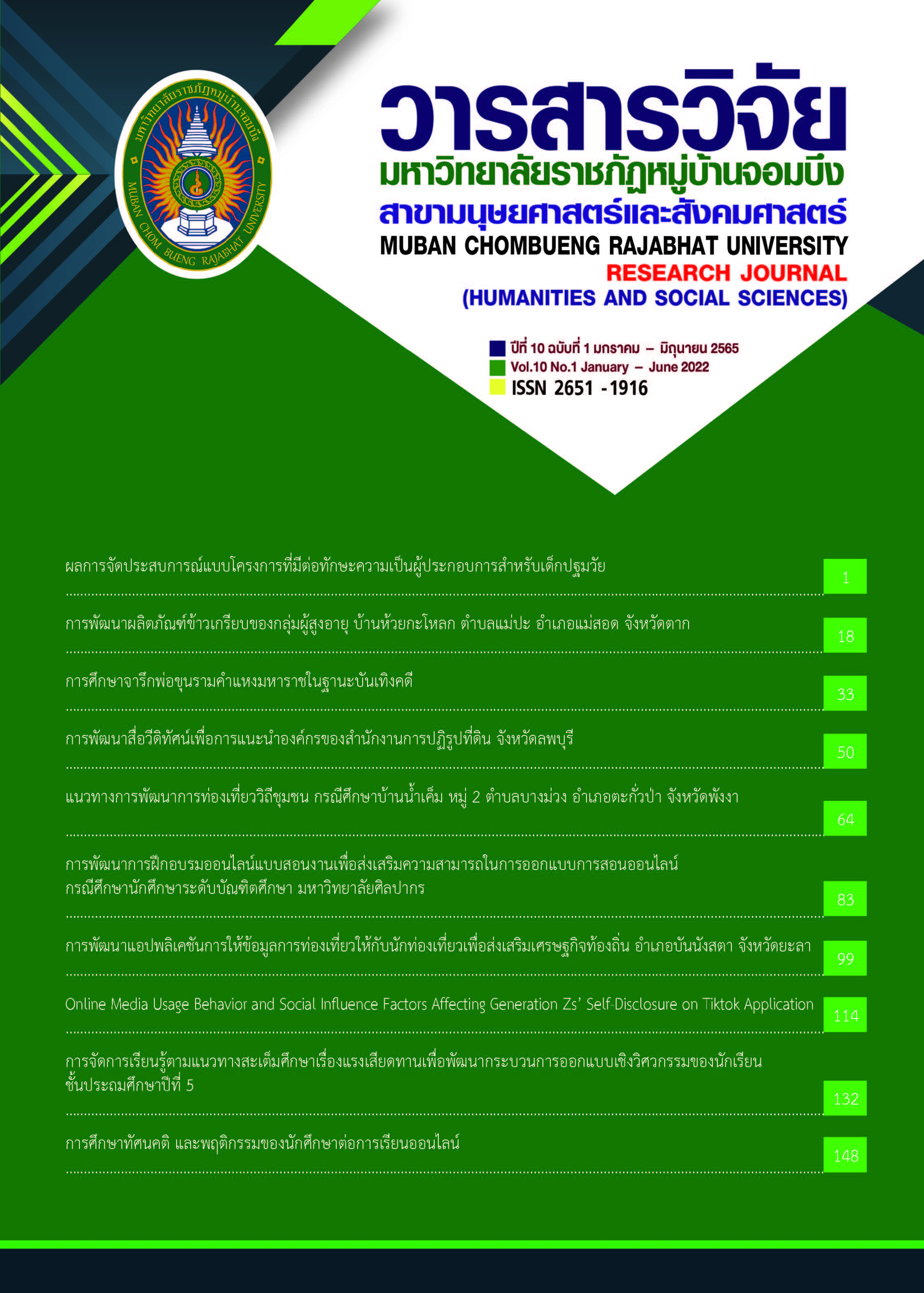การจัดการเรียนรู้ตามแนวทางสะเต็มศึกษาเรื่องแรงเสียดทานเพื่อพัฒนากระบวนการออกแบบเชิงวิศวกรรมของนักเรียนชั้นประถมศึกษาปีที่ 5
คำสำคัญ:
การจัดการเรียนรู้ตามแนวทางสะเต็มศึกษา, กระบวนการออกแบบเชิงวิศวกรรม, แรงเสียดทานบทคัดย่อ
การวิจัยในครั้งนี้มีวัตถุประสงค์เพื่อพัฒนากระบวนการออกแบบเชิงวิศวกรรมของนักเรียนชั้นประถมศึกษาปีที่ 5 ด้วยการจัดการเรียนรู้ตามแนวทางสะเต็มศึกษา กลุ่มตัวอย่างที่ใช้ในการวิจัย ได้แก่ นักเรียนชั้นประถมศึกษาปีที่ 5 จากโรงเรียนชุมชนบ้านบ่อ อำเภอสวนผึ้ง จังหวัดราชบุรี จำนวน 32 คน แบบเจาะจง เครื่องมือที่ใช้ คือ 1. แผนการสอน เรื่อง แรงเสียดทาน 2. แบบสังเกตกระบวนการออกแบบเชิงศวกรรมศาสตร์ โดยมีค่าดัชนีความสอดคล้องอยู่ระหว่าง 0.60-1.00 ซึ่งเก็บข้อมูลโดยใช้แบบสังเกต และใบกิจกรรม จากนั้นทำการวิเคราะห์ข้อมูลเชิงคุณภาพและปริมาณ ได้แก่ การวิเคราะห์ด้านเนื้อหาและการหาร้อยละ
ผลการวิจัย พบว่า 1) จากการประเมินโดยผู้เชี่ยวชาญ พบว่ากิจกรรมการในชั้นเรียนด้วยการจัดการเรียนรู้ผ่านสะเต็มศึกษาที่ออกแบบขึ้นมีความสอดคล้องตามแนวทางสะเต็มศึกษาและมีกระบวนการที่เป็นไปตามรูปแบบของกระบวนการออกแบบเชิงวิศวกรรมศาสตร์ 2) นักเรียนที่ผ่านการจัดกิจกรรมการเรียนรู้ในชั้นเรียน เรื่อง แรงเสียดทาน ด้วยกิจกรรมเรือน้ำใจช่วยผู้ประสบภัย โดยการจัดการเรียนรู้ผ่านสะเต็มศึกษาเกิดกระบวนการออกแบบเชิงวิศวกรรมศาสตร์ผลการประเมินในภาพรวมทั้ง 5 ขั้นอยู่ในระดับดีมาก
เอกสารอ้างอิง
กระทรวงศึกษาธิการ.(2563).ตัวชี้วัดและสาระการเรียนรู้แกนกลางกลุ่มสาระการเรียนรู้วิทยาศาสตร์ (ฉบับปรับปรุง พ.ศ. 2560)ตามหลักสูตรแกนกลางการศึกษาขั้นพื้นฐาน พุทธศักราช 2551.กรุงเทพมหานคร:โรงพิมพ์ชุมนุมสหกรณ์การเกษตรแห่งประเทศไทย จำกัด.
กวิน เชื่อมกลาง.(2556).กิจกรรมสะเต็มหรรษา:ลูกโป่งน้ำบันจีจัมป์.สถาบันส่งเสริมการสอนวิทยาศาสตร์ และเทคโนโลยี(สสวท.),41(182),26-29.
นิตยา ภูผาบาง.(2559).การใช้กิจกรรมสะเต็มศึกษา เรื่อง พลาสติกชีวภาพจากแป้งมันสำปะหลังเพื่อพัฒนาทักษะกระบวนการทางวิทยาศาสตร์ขั้นบูรณาการสำหรับนักเรียนชั้นมัธยมศึกษาปีที่ 2. ใน การประชุมวิชาการบัณฑิตศึกษาระดับชาติและนานาชาติ ครั้งที่6.(หน้า H332-H345). กรุงเทพ: บัณฑิตวิทยาลัย มหาวิทยาลัยศิลปากร.
นัสรินทร์ บือชา.(2558).ผลการจัดการเรียนรู้ตามแนวคิดสะเต็มศึกษา(STEM Education) ที่มีต่อผลสัมฤทธิ์ทางการเรียนชีววิทยา ความสามารถในการแก้ปัญหาและความพึงพอใจต่อการ จัดการเรียนรู้ของนักเรียนชั้นมัธยมศึกษาปีที่ 5 (วิทยานิพนธ์ปริญญาศึกษาศาสตร์มหาบัณฑิต).มหาวิทยาลัยสงขลานครินทร์ วิทยาเขตปัตตานี, ปัตตานี.
พลศักดิ์ แสงพรมศรี.(2558).การเปรียบเทียบผลสัมฤทธิ์ทางการเรียน ทักษะกระบวนการทาง
วิทยาศาสตร์ขั้นสูง และเจตคติต่อการเรียนเคมีของนักเรียนชั้นมัธยมศึกษาปีที่ 5 ที่ได้รับการจัดการเรียนรู้สะเต็มศึกษากับแบบปกติ.วารสารศึกษาศาสตร์ มหาวิทยาลัยมหาสารคาม,9(ฉบับพิเศษ),401 - 418.
ภัสสร ติดมา.(2558).การพัฒนาความคิดสร้างสรรค์ เรื่อง ระบบร่างกายมนุษย์ ด้วยกระบวนการออกแบบเชิงวิศวกรรมตามแนวทางสะเต็มศึกษาระดับชั้นมัธยมศึกษาปีที่ 2.วิทยานิพนธ์ปริญญา ศึกษาศาสตรมหาบัณฑิต, สาขาวิชาวิทยาศาสตร์ศึกษา,คณะศึกษาศาสตร์, มหาวิทยาลัยนเรศวร.
สกนธ์ชัย ชะนูนันท์.(2559).รูปแบบการจัดการเรียนรู้ ตามแนวคิดสะเต็มศึกษา. เอกสารประกอบการอบรมเชิงปฏิบัติการ การออกแบบการจัดการเรียนรู้สะเต็มศึกษา ตามโครงการอบรมเชิงปฏิบัติการพัฒนาครูด้านการจัดการเรียนรู้ตามแนวคิดสะเต็มศึกษา.นครสวรรค์: สำนักงานเขตพื้นที่การศึกษามัธยมศึกษา เขต 42 กระทรวงศึกษาธิการ.
สุวิษย์ เมษินทรีย์.(๒๕๕๙).Thailand 4.0 กับบทบาทการขับเคลื่อนของมหาวิทยาลัยในงานประชุมสภามหาวิทยาลัยสงขลานครินทร์ (หน้า 19-21). สงขลา: มหาวิทยาลัยสงขลานครินทร์.
Strimel, G. (2014). Shale Gas Extraction: Drilling Into Current Issues and Making STEMConnections. Technology and Engineering Teacher, 73(5), 16-24
ดาวน์โหลด
เผยแพร่แล้ว
รูปแบบการอ้างอิง
ฉบับ
ประเภทบทความ
สัญญาอนุญาต
ลิขสิทธิ์ (c) 2022 วารสารวิจัยมหาวิทยาลัยราชภัฏหมู่บ้านจอมบึง สาขามนุษยศาสตร์และสังคมศาสตร์

อนุญาตภายใต้เงื่อนไข Creative Commons Attribution-NonCommercial-NoDerivatives 4.0 International License.
วารสาร TCI อยู่ภายใต้การอนุญาต Creative Commons Attribution-NonCommercial-NoDerivatives 4.0 International (CC BY-NC-ND 4.0) เว้นแต่จะรุบุไว้เป็นอย่างอื่นโปรดอ่านหน้านโยบายของเราสำหรับข้อมูลเพิ่มเติมเกี่ยวกับการเช้าถึงแบบเปิด ลิขสิทธิ์ และการอนุญาต



